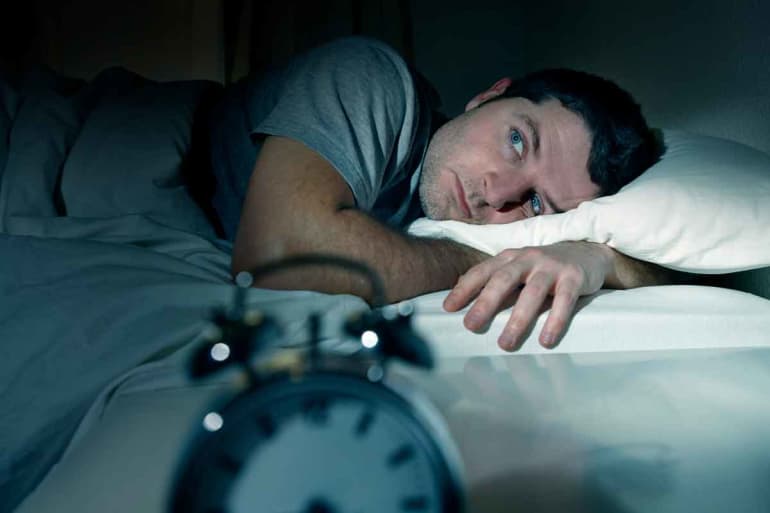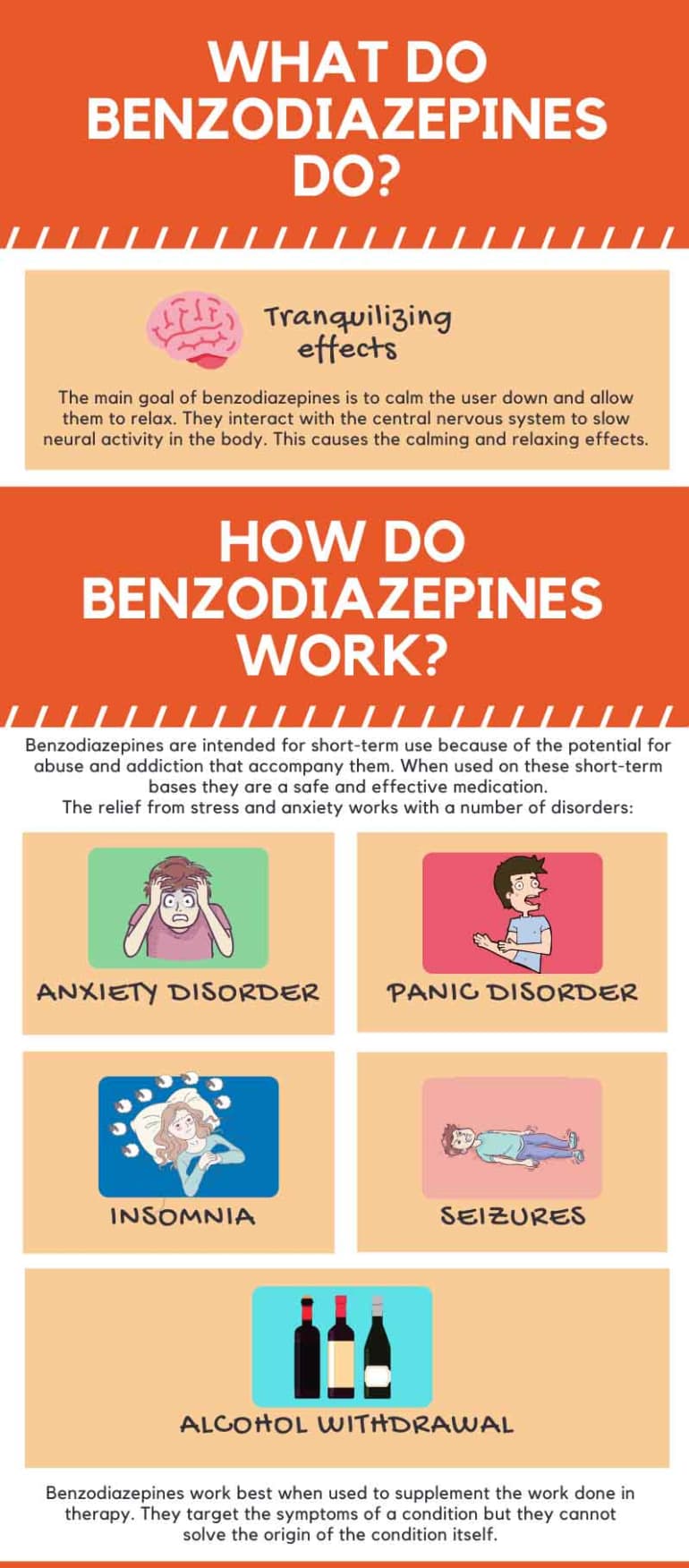Benzodiazepines are a class of prescription drugs mainly used to treat anxiety and insomnia. Some doctors use them to treat certain cases of tremors, seizures, muscle spasms, and drug and alcohol withdrawal symptoms. They calm a person’s body or nerves by interacting with the central nervous system (CNS).
The calming effects of benzodiazepines are also used for recreational purposes. They result in feelings of a slowed, relaxed euphoria that is popular with drug addicts seeking a high. Statistics show a massive increase in their popularity over the past decade which shows no sign of slowing down.
What Benzodiazepine Means
First introduced in the 1960s, benzodiazepines provided a safer and more effective alternative to older drugs like barbiturates. Doctors regarded the medication for its place in the new era of treating difficult cases of anxiety and insomnia. They’ve been a popular medication since first hitting the market, despite the introduction of even newer alternatives.

Benzodiazepines reduce the feelings of anticipation and nervousness associated with anxiety. These effects help people with generalized anxiety disorder and sleeping difficulties. People with panic disorders benefit from these drugs because the reduced anxiety keeps them from avoiding panic-inducing places and situations.
But they also mean different things depending on the person using them. For people struggling with intense anxiety and panic disorders, these drugs are a life-saving medication. People who prefer them for recreational use, though, find they might mean something as life-threatening as an accidental overdose when combined with other drugs.
They help thousands of people reintegrate back into society despite their struggles with anxiety. At the same time, they threaten the lives of people who use them as a way to escape from the world around them. It all depends on the intention of the user.

Benzodiazepine abuse is a serious and growing problem throughout the U.S., but finding the right benzodiazepine addiction treatment in Hawaii can help.
More infoWhat Are Benzodiazepines Made Of?
Benzodiazepines refer to a variety of different prescription medications, all with a benzodiazepine base. They are classified as minor tranquilizers or sedatives depending on the properties of the specific medication.
Additionally, doctors separate the drugs into four different classes based on their effects: sedative-hypnotic, anti-anxiety, muscle relaxant, and anti-convulsant. Each medication has slightly varying benefits depending on what it is made from.
Sedative-Hypnotic
Sedative-hypnotic drugs are used to treat people with insomnia and other sleep disorders. The sedative effects relieve and calm the anxiety associated with lack of sleep while the hypnotic effects induce sleep itself. Common sedative-hypnotic prescriptions include temazepam (Restoril) and triazolam (Halcion).
Anti-Anxiety
Anti-anxiety drugs are used to treat cases of generalized anxiety disorder, panic disorder, and other anxiety disorders. They depress the CNS which relieves the extreme anticipatory anxiety often associated with these disorders. Anti-anxiety medications are some of the more popular drugs, including alprazolam (Xanax), chlordiazepoxide (Librium) and lorazepam (Ativan).
Muscle Relaxant
Muscle relaxants, or muscle relaxers, relieve tension in the muscles or muscle spasms. They slow down neuron activity that would usually lead to pain in a person’s muscles. Diazepam (Valium) is the most common benzodiazepine muscle relaxant.
Anti-Convulsant
Anti-convulsant drugs treat epileptic seizures and seizures that result from alcohol withdrawals. They interact with a specific GABA subtype that regulates sedative effects and anticonvulsant activity in the body. Common benzodiazepine anti-convulsant medications include diazepam (Valium) and clonazepam (Klonopin).
Chemistry of Benzodiazepines
Despite the variations in different prescriptions, benzodiazepines all use the same basic structure. Their primary function is to raise levels of GABA neurotransmitters in the brain. GABA, or gamma-aminobutyric acid, is responsible for slowing the activity of neurons. Slowing these neurons down results in a calmer and more relaxed state of being for the user.
The human body is equipped with two different types of benzodiazepine receptors: one that affects anxiety and the other that affects sedation. This is how the overall calming effects of benzodiazepines affect a person’s levels of anxiety and sedation.
There are both fast-acting and slow-acting types of benzodiazepines. The effects of these drugs range from shorter than 6 hours to longer than 24 hours. Since they slow brain activity, higher doses of the medication may cause feelings of drowsiness, reduce reaction time, affect balance and coordination, and impact memory.
The chemistry of benzodiazepines also leads to dependence on the drug. GABA neurotransmitters get used to the presence of benzodiazepines. This means a person needs more of the medication over time to achieve the same effects and they’ll also experience withdrawal symptoms after they stop taking it.
Why Are They Called Benzodiazepines?
Prescription benzodiazepines get their name from their chemical composition. Every benzodiazepine medication is made from a benzene ring fused with a diazepine ring. Some also include a phenyl ring which contributes to the differences between drugs. This chemical combination of benzene and diazepine gave the medication its name: benzodiazepine.
Other Names for Benzodiazepines
Most people refer to benzodiazepines by their brand names, like Xanax, Valium, Ativan, or Klonopin. People who use them as prescribed don’t refer to them as much else aside from their names. Those who use benzodiazepines recreationally have many different street terms and slang names for the drugs.
Street Names and Nicknames for Benzodiazepines
There are a variety of different names for benzodiazepines, including names for some of the brands of prescription drugs. Benzodiazepines in general are most often referred to as “benzos” or “downers”. Some people also call them “tranks” or “nerve pills”.
Another benzodiazepine with a number of street names is Xanax. It is one of the, if not the most-abused benzodiazepines today, and commonly talked about in mainstream music. People refer to them with a variety of names including:
- Xannies
- Zannies
- Bars
- Xanbars
- Handlebars
- Blue Footballs
Where Do Benzodiazepines Come From?
Barbiturates were a popular drug used to treat anxiety, sleeping problems, and seizures in the mid-1900s. These powerful sedative-hypnotic drugs helped many people looking for solutions to their overwhelmed nervous systems.

Doctors noticed that barbiturates slowed some patients’ breathing rates to dangerous levels, though. They also came with a dependency problem seen with many early medications. These factors caused a widespread safety concerns surrounding the use of barbiturates and raised the need for an alternative medication.
Benzodiazepines are an effective replacement for barbiturate medications but where do they come from? Who discovered the first benzodiazepine and how did their use spread afterward?
Who Discovered Benzodiazepines?
Librium, the first benzodiazepine, was created in 1955 by Leo Sternbach. He was a chemist employed by the Hoffmann-La Roche pharmaceutical company. He and his team worked on discovering a safer alternative to the life-threatening barbiturates on the market at the time.
Hoffmann-La Roche marketed Librium to the public in 1960 and doctors quickly latched onto the barbiturate replacement. Valium followed soon after Librium, launching onto the market in 1963. These benzodiazepines suppressed a patient’s CNS enough to ease anxiety but not to the point of alarming respiratory distress.
They also aimed to push back against the dependency-forming aspects that came with barbiturate use. Like other medications, benzodiazepines were first created to solve many of the problems seen with previous forms of similar medications, such as opiates.
Doctors prescribed benzodiazepines extensively which caused both their popularity and demand to skyrocket. Drugs like Librium and Valium topped the “most prescribed medications” lists throughout the 1970s.
As the 1980s came around, though, doctors noticed a benzodiazepine dependence and addiction problem reminiscent of the drug they replaced. This led the government to create the first rounds of legislation surrounding benzodiazepine prescription and use.
When new residents enter rehab at Hawaii Island Recovery, they often have questions about what life will look like during their stay and how their habits will change throughout the program.
Use of Benzodiazepines
Benzodiazepines are a helpful, life-saving medication when used as prescribed. Their CNS-depressant properties make them an effective anti-anxiety and sleep medication. They also offer an effective alternative to more common seizure medications when necessary.

Despite all of the helpful uses for benzodiazepines, though, there are still people who misuse them. The calming, euphoric effects of these drugs entice those looking for another high. Some publications even make the case for benzodiazepines being a second drug epidemic alongside prescription opioids.
What are some of the ways benzodiazepine medications are used? In which cases do they help people and in which cases do they hurt them?
Medical Use of Benzodiazepines
There are two types of benzodiazepines: tranquilizers and sedatives. Tranquilizers help relieve insomnia while sedatives relieve sleeping problems. Both types are chemically similar, though, and interact with the body’s central nervous system to calm the user down.
Benzodiazepines are helpful for people who struggle with extreme cases of generalized anxiety disorder or panic disorders. They calm the feelings of anticipatory anxiety associated with both types of disorders which allows them to navigate daily life more effectively.
They also help relieve the nighttime anxiety associated with sleeping problems. People who have a difficult time winding down enough to fall asleep at the end of the day find relief with benzodiazepines. The medication calms their mind and body and encourages sleep.
Regardless of the number of people they help, benzodiazepine use is still on the rise even for legitimate medical reasons. One study revealed the rates of benzodiazepine prescriptions offered during medical visits doubled between 2003 and 2015.
Recreational Use of Benzodiazepines
Recreational benzodiazepine use remained consistent between 2015 and 2017 but saw a slight drop in 2018. About 2.4 percent of people ages 12 and older, or 5.4 million people, misused a benzodiazepine medication at least once during the year. This is down from the 2.5 percent of people who misused them at some point during 2017.
There were also 751,000 people in the same age range with a tranquilizer or sedative use disorder in 2018. They showed repeated use of these drugs to the point that it interfered with their lives, such as problems with work, school, family, or their health. Rates of tranquilizer or sedative use disorder are similar to previous years, meaning they show no signs of slowing.
What Do Benzodiazepines Do?
The main goal of benzodiazepines is to calm the user down and allow them to relax. They trigger a chemical in the brain that tranquilizes the person. These medications provide relief from the symptoms of conditions such as anxiety, insomnia, panic disorder, or seizures.
Most benzodiazepines have similar effects despite the various types of medications that exist. Doctors use various prescriptions for different reasons, such as the condition in question or a patient’s reaction to previous medications.
Tranquilizing effects of benzodiazepines calm the hyperactivity and over-excitement in a patient’s brain. The medication is already at work when a person is in a situation that would normally trigger symptoms of anxiety. They relieve those overwhelming feelings and allow the person to navigate life effectively.
How Do Benzodiazepines Work?
Although benzodiazepines are helpful medication, they are not a solution to the conditions. They are intended for short-term use because of the potential for abuse and addiction that accompany them. When used on these short-term bases they are a safe and effective medication.
Benzodiazepines work best when used to supplement the work done in therapy. They target the symptoms of a condition but they cannot solve the origin of the condition itself. It’s best to work on the disorder in therapy while using medication to relieve symptoms during that time. This
allows therapists and clients to do effective work with less distraction from symptoms.
They interact with the central nervous system to slow neural activity in the body. Slowed neural activity causes the calming and relaxing effects that benzodiazepines are known for. The relief from stress and anxiety works with a number of disorders.
Generalized Anxiety Disorder (GAD)
Benzodiazepines are best known for their quick impact on symptoms of anxiety. They are used as a tool to work with individuals who have generalized anxiety disorder. Short-term use is recommended when used to treat GAD so clients don’t become reliant upon the medication.
Panic Disorder
The calming, anxiety-relieving effects of benzodiazepines are also effective in treating clients with panic disorders. They offer fast-acting relief from overwhelming nervousness that leads to panic attacks. Again, short-term use is recommended while working on the deeper issues that result in a person’s panic attacks.
Insomnia
People with insomnia find relief from their sleeplessness with the help of benzodiazepines. They are at a high risk of developing a dependence, though, due to the much-needed sleep that the medication encourages. Benzodiazepines are a helpful tool to encourage sleep while working on deeper issues to avoid dependence.
Seizures
Certain types of benzodiazepines function as strong anticonvulsant medications. They are a powerful medication for limiting or stopping epileptic seizures.
Alcohol Withdrawal
Benzodiazepines are the most common medication used when treating symptoms of alcohol withdrawal. They relieve the effects of the overactive central nervous system that is common while detoxing, including anxiety, insomnia, and seizures.
How Long Do Benzodiazepines Stay in Your System?
Many people wonder how long benzodiazepines stay in their system. The answer depends on the specific kind they take. There are two different categories of benzodiazepine medications: short-acting and long-acting.
Short-acting prescriptions absorb quickly in the bloodstream and cause effects to come on quickly. They also clear out of the person’s system in a short period of time. Long-acting prescriptions absorb slower and some have a stockpile affect where they accumulate and lead to longer-lasting effects. These medications take longer to clear out of the system.
Long-acting benzodiazepines have a half-life of longer than 24 hours, meaning they remain in a person’s system for around a week. Most of the medication clears out within two weeks of the last dose.
Half-lives of short-acting benzodiazepines range from 5 to 24 hours depending on the type of medication it is. Still, the majority of short-acting medications clear out of a person’s system within a week.
There are also some ultrashort-acting benzodiazepines with a tiny half-life. These medications have a half-life of less than 5 hours which means the effects come on quickly then clear out quickly.


Healing at Our Hawaii Residential Center We offer residential treatment programming at our rehab center for a minimum of 30 days and up to 90+ days, depending on medical necessity. Residential Treatment Center in Hawaii We offer residential treatment programming at our rehab center for a minimum of 30 days…
More infoEffects and Dangers of Benzodiazepines
Like most medications, doctors first adopted benzodiazepines as a safer alternative to a then-popular medication. Barbiturates slowed patients’ breathing to dangerous levels which required a better solution.

Benzodiazepines stepped in to take their place. They relieved some concerns but raised still others. Doctors realized the incredible addiction potential that came with these medications. They have their own set of dangerous side effects that were magnified when people abused them.
What are the dangers of benzodiazepine use? How much risk are people at when taking these medications, either as prescribed or recreationally? Is there a safe way for people to use benzodiazepines?
Are Benzodiazepines Dangerous?
Benzodiazepines are a life-saving medication when used only as prescribed. They’re intended for short-term use while addressing the core issues in therapy or another form of treatment. After a set number of weeks of treatment, doctors should wean their patients off of these medications.
Problems arise when people start using them on a long-term basis. Dependence is inevitable after a certain amount of time. But the risk of abuse and addiction rises significantly when using them for longer than a couple months.
It isn’t incredibly dangerous to use benzodiazepines on their own. The real danger arises in the way they interact with alcohol or other medications. Both people who use benzos as prescribed and recreationally are at risk for combining them with other substances.
Drinking while on benzodiazepines is one of the most dangerous combinations. Both substances depress, or slow, the central nervous system. This can quickly lead to benzodiazepine intoxication and can possibly be lethal.
What is Benzodiazepine Intoxication?
Benzodiazepine medications aren’t necessarily dangerous used on their own. At low doses they encourage relaxation and relieve anxiety. High doses of benzos, or combining them with other substances, though, can lead to benzodiazepine intoxication.
Benzodiazepine intoxication describes the condition brought on by toxic levels of chemicals in the user’s system. The effects of benzodiazepine intoxication are both dangerous and scary, leaving the user significantly inebriated. Effects include:
- Blurred vision
- Slurred speech
- Confusion
- Dizziness
- Drowsiness
- Weakness
- Poor coordination
- Limited motor skills
- Labored breathing
- Coma
The effects of benzodiazepine intoxication can be life-threatening if not treated immediately. If you see someone with any of the above signs, call for medical assistance as soon as possible.
Are Benzodiazepines Addictive?
At lower doses used for prescriptions, benzodiazepines cause dependence. Drug dependence and drug addiction are two separate conditions. Dependence refers to the way the body develops a physical or psychological need for a substance after using it for some time.
Most people with a benzodiazepine develop a dependence on the drug and need to be weaned off. But does everyone with a prescription become addicted to benzodiazepines?
There are a few differences between drug addiction and drug dependence. Drug addiction describes the compulsive use of drugs despite the consequences that arise. People who struggle with drug addiction usually place their addiction ahead of anything else.
People can develop a benzodiazepine addiction. The calming, euphoric, pleasurable effects of benzos draw many people in. This portion of people find themselves hooked on those effects and doing all they can to live in that drug-induced state.
What is Benzodiazepine Withdrawal?
Drugs that cause physical or psychological dependence eventually result in withdrawal symptoms. Withdrawal symptoms are the physical and psychological effects of a substance clearing from your body.
Benzodiazepine withdrawal symptoms tend to be the same types of symptoms that benzos treated in the first place. Their CNS-suppressing effects are no longer in place, leaving a person more susceptible and sensitive to their surroundings. Effects of benzodiazepine withdrawal include:
- Restlessness
- Irritability
- Anxiety
- Panic attacks
- Depression
- Insomnia
- Nausea
- Vomiting
- Headaches
- Body aches
- Muscle spasms
- Tremors
- Hyperventilation
- Difficulties focusing
- Sensitivity to light and touch
- Hallucinations, including auditory, tactile, or visual hallucinations
- Seizures
The severity of benzodiazepine withdrawal symptoms depends on a few factors:
- Type of medication taken
- Amount of medication taken
- Length of time medication was taken
- Whether combined with other drugs
- Previous substance abuse issues
Left untreated, benzodiazepine withdrawal symptoms can be life-threatening. It is best to first send someone addicted to benzos to a detox program. Doctors can safely wean them off the drugs in order to avoid the more dangerous effects of withdrawals.
Get Addiction Treatment
If you or a loved one need help, call Hawaii Island Recovery toll-free right now.
866-390-5070 Hawaii Island Recovery
Hawaii Island Recovery 










